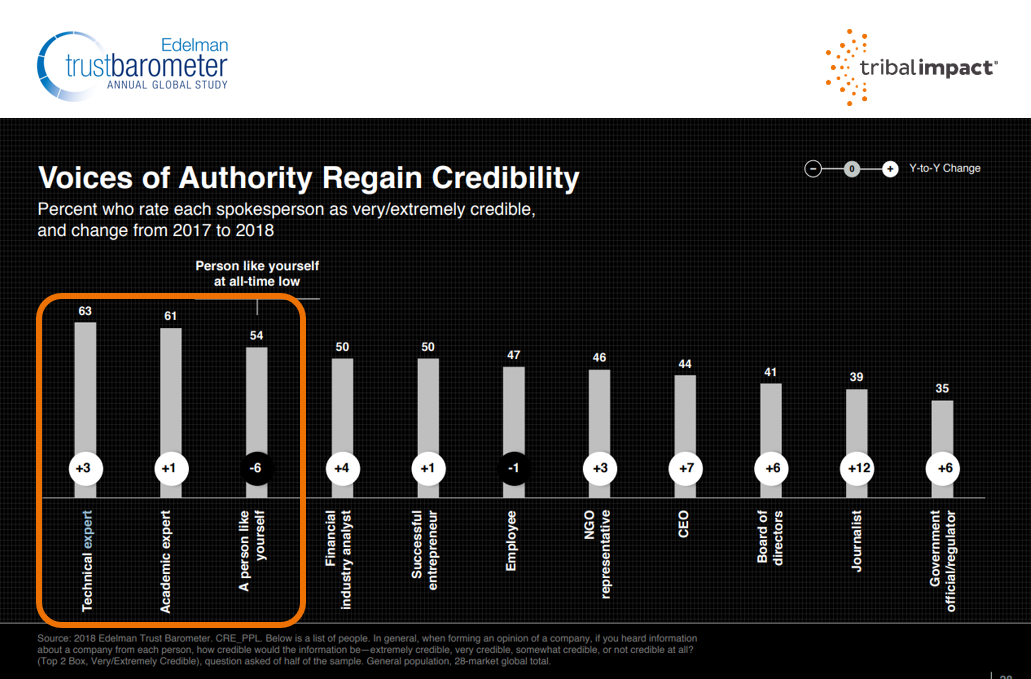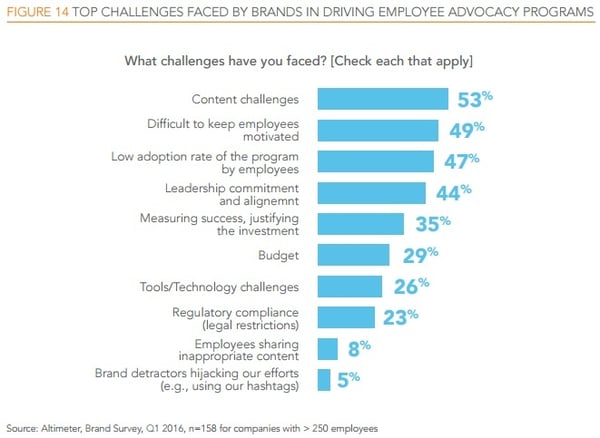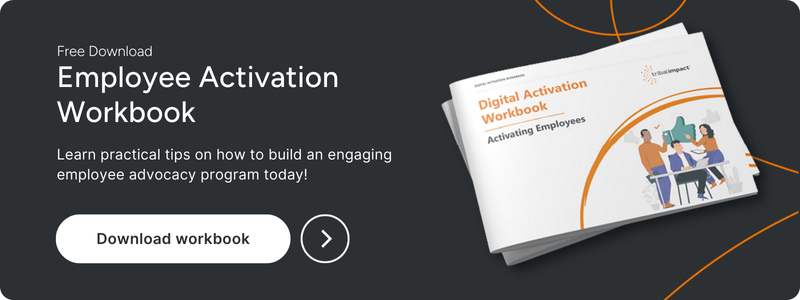We all know the proverb that a bad workman blames his tools. But we also know that a good workman knows when they don’t cut it and always seeks to find better ones. So if you’re looking for the best employee advocacy tool, here’s our overview on some of the tools available.
You may well have already adopted an employee advocacy program and in 2017, 82% of companies surveyed by JEM Consulting and Advisory Services had done so. In fact, a staggering 25% had embraced it in that year alone.
But by now, you may be wondering if you’ve got the right employee advocacy tool for you. Maybe your licence is up for renewal and you’re not seeing the results you (or the Board) hoped for.
Or maybe you’re just gearing up to make your employees your brand ambassadors but the comparison process is overwhelming. After all, most of the sales pitches sound pretty similar.
So look no further. As we move into 2020, we’re sharing our unbiased opinion on:
- Our view of the top 12 employee advocacy tools out there
- which tools suit different budgets
- the 8 features to look for
- the questions you should ask every provider.
Our Pick Of The Best Employee Advocacy Tools
Back in 2016, our founder, Sarah Goodall, wrote a blog called 19 Employee Advocacy Tools Worth Checking Out. Since then of course, the tools have advanced and we've also seen what’s becoming most popular with our clients (and which features we love working with).
So here’s our top 12 list, in no particular order (we couldn’t limit it to 10!):
LinkedIn Elevate - will be closing down in December 2020
Qubist
What To Look For: The 8 Best Employee Advocacy Tool Features
People are much more likely to trust the content that your company experts' create and share than your CEO's or journalists. (Edelman’s Trust Barometer). Even regular employees’ content is more credible. And both are growing at a much faster rate than the traditional top-down approach.

Fortunately, employee advocacy tools have moved beyond mass-sharing marketing-created content and most now enable employees to customise posts (and if they don’t, then skip past them.)
But some tools offer much more advanced features that can help you:
- create authentic content
- improve your audience reach and impact
- measure and analyse your efforts
- stay compliant
- engage employees.
So without further ado...here are 8 features to consider.
1. Gamification: Motivating Your Employees (or is it?)
Implementing your employee advocacy tool is one thing, but motivating your employees to use it is another one entirely.
Most tools now offer gamification features which reward points for activity levels, with leaderboards. Some, such as SMARP, allow you to set perks and rewards based on adjustable milestones. And Sociabble offers a whole host of gamification and engagement features.
Whilst gamification is taking off, it’s important to remember a few fundamentals. It’s not about iPads and vouchers. It’s about instilling a recognition and a sense of purpose.
Consider linking your gamification to rewards such as:
- Exclusive masterclasses for superstars
- Calling out best practice examples
- Inviting Social Champions to prestigious client/networking events
I know some companies like to hand out branded goodies as well but personally, it doesn’t work for me.
2. Editing Options Without The 'eek'
Encouraging authenticity is great. But there’s a reason some run scared at the prospect of employee advocacy - the looming threat of legal action or reputational damage.
With the right social media compliance training, you can curtail this risk. So why not make your job easier with administrator approval features for edited posts and suggestions? GaggleAmp, EveryoneSocial, LinkedIn Elevate, SMARP, HootSuite Amplify and Sociabble all offer this feature.
Dynamic Signal goes a step further. It enables you to blacklist words/phrases to maintain brand voice and compliance - minimising the risk that posts will be rejected.
If you're in a regulated industry then it's worthwhile looking into Qubist or CommandPost. Not only do they automatically alert EA Managers to potential compliance breaches, they also make providing auditing documentation easy. Qubist takes the hard work out of compliance set-up, with pre-built content categories, policies and reports for different industries and specific regulations. CommandPost doesn’t offer this, but it does make disclosure ‘clear and conspicuous’ with a range of built-in disclosure URLs.,
3. A Cure For Content Curation Headaches
Curating relevant and quality content can quickly become a headache. In fact, sourcing content is the biggest challenge for employee advocacy leaders. (Source: Altimeter, a Prophet company.)

Most tools now offer content aggregation features, pulling content from selected sources e.g. RSS feeds, social media channels and hashtags. (Although it’s worth noting that LinkedIn Elevate only pulls content from its own channel.)
But if you want to optimise your content curation further, these tools offer extra features:
- EveryoneSocial users can set up their own personal feeds. (A great feature when trying to encourage authentic voices.)
- Grapevine 6 uses Artificial Intelligence to learn and suggest what content your teams like.
4. Encourage User-Generated Content
Enabling your employees to edit your carefully-crafted marketing posts is one thing. If the tool helps them source their own content it can take your advocacy program to the next level. Here’s why:
- It enhances your employees’ authenticity. They’re best-placed to know what interests your customers or clients.
- It makes your content curator’s job a lot easier.
Dynamic, EveryoneSocial, Amplify, PostBeyond, SMARP and Sociabble all allow user submissions.
Yet Sociabble and Everyone Social lead the way. Instead of having to submit content via the tool, their chrome extensions enable users to save and submit content as they surf. If you can make it easier to share, why wouldn’t you?
5. Go Beyond Simply Sharing And Posting
If you want to encourage good social etiquette, it's about much more than just preventing “me me me” spamming. It's also about who you connect with, what you follow and the posts you like and comment on.
Social media training is a must for a successful program. But it always helps to have a tool to simplify things! This is where GaggleAmp shines. Admin can not only recommend posts to share - they can recommend other actions like writing reviews or commenting on posts.
6. Advanced Analytics
Your Earned Media Value is a pretty invaluable metric to report to the board (and help you encourage take-up).
You can make this process easier with tools that do this for you e.g.
Dynamic Signal and Everyone Social, LinkedIn Elevate, PostBeyond, SMARP and Sociabble.
PostBeyond also offer an Intelligence Post Performance ranking, which helps users and managers quickly identify top-performing content - even analysing word groupings to detect common themes that extend reach and engagement.
7. Auto-Scheduling
Auto-scheduling posts is a must for busy employees, so that they can post in bulk. We’d recommend looking at tools that allow you to optimise when posts are scheduled for each network.
All the tools we mentioned offer auto-scheduling but it’s worth digging a bit deeper to find out about the functionality and what suits your business.
8. Integrations For End-To-End Visibility
It’s very hard to report on the overall impact of your employee advocacy program if it’s not linked to your marketing efforts. Most (but not all) tools allow you to quickly add UTM parameters to the end of your links so that you can measure their impact.
Many go further and will integrate with popular sales and marketing platforms. But do they integrate with your software?
Everyone Social’s integrations appear to lead the way with 29 integrations. Yet if a tool offers Zapier integration, it can connect you with thousands of apps such as Hubspot, SalesForce, Oracle, Slack and more. (Smarp, Hootsuite and LinkedIn Elevate offer this.) And Dynamic Signal offer an open API offering, meaning any developer can integrate it into their platform.
The Questions You Should Ask Every Employee Advocacy Tool Provider
Here are some starter questions you should ask any tool provider. For more in-depth questions check out: The Many Questions to Ask Before Investing in an Employee Advocacy Tool.
- How can you access the tool? Is it fully responsive in each mode?
- How is content curated into the tool?
- Can you categorise content and customise it for different users?
- Can employees edit posts and suggest content?
- What compliance mechanisms are in place? Can we adapt the requirements for different types of posts?
- How can users add content to the platform (and how long does it take)?
- What gamification options do they provide? Are they customisable? Are they automatically rewarded?
- What training do they offer?
- How do you scale up the licensing?
- The T&Cs: minimum periods, cancellation policies, etc.
- How do they meet GDPR and data protection laws?
- What are the permission levels and is there a maximum amount e.g. for approval or curation rights?
- What analytics tools are available within the platform? How exactly do you identify top performers and top performing content? Do they include Earned Media Value?
- What integrations do they provide? Do they take care of this for you?
And last, but not least!
- How do you charge for the tool? E.g. license based, pay per engagement, flat fee
As you can see, choosing the right tool for your business is going to come down to a number of factors, such as: how many employees need to use it, how easy it is to use, how compliance-focused your business is and what software integrations you require. Then, and probably most important, there’s your budget. So before you commit, make sure those extra functions are worth the money for you - happy tool hunting !

